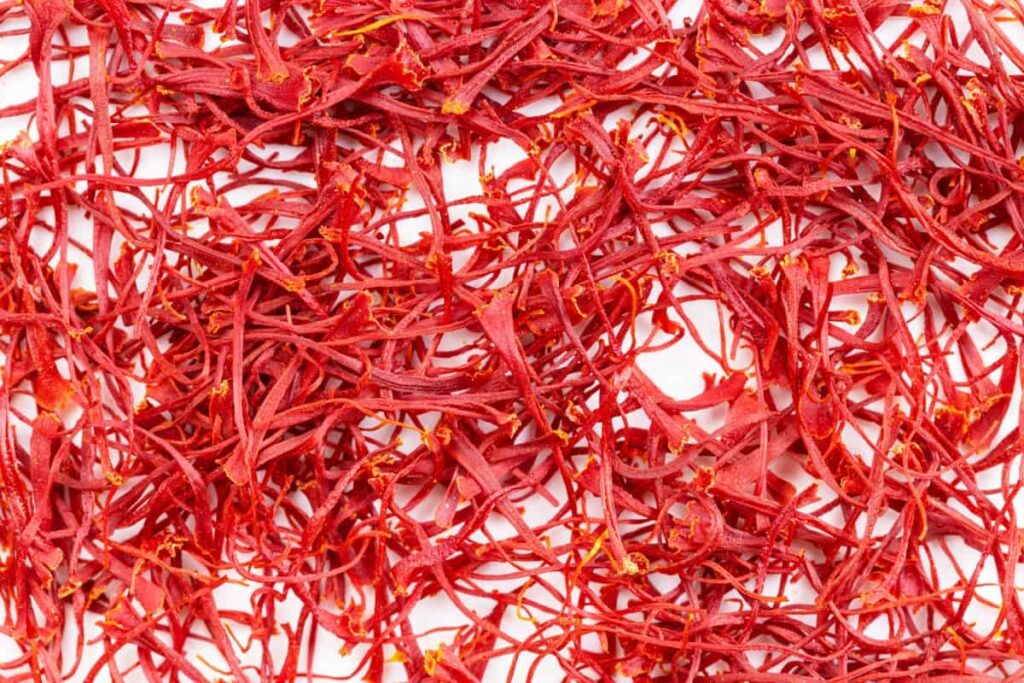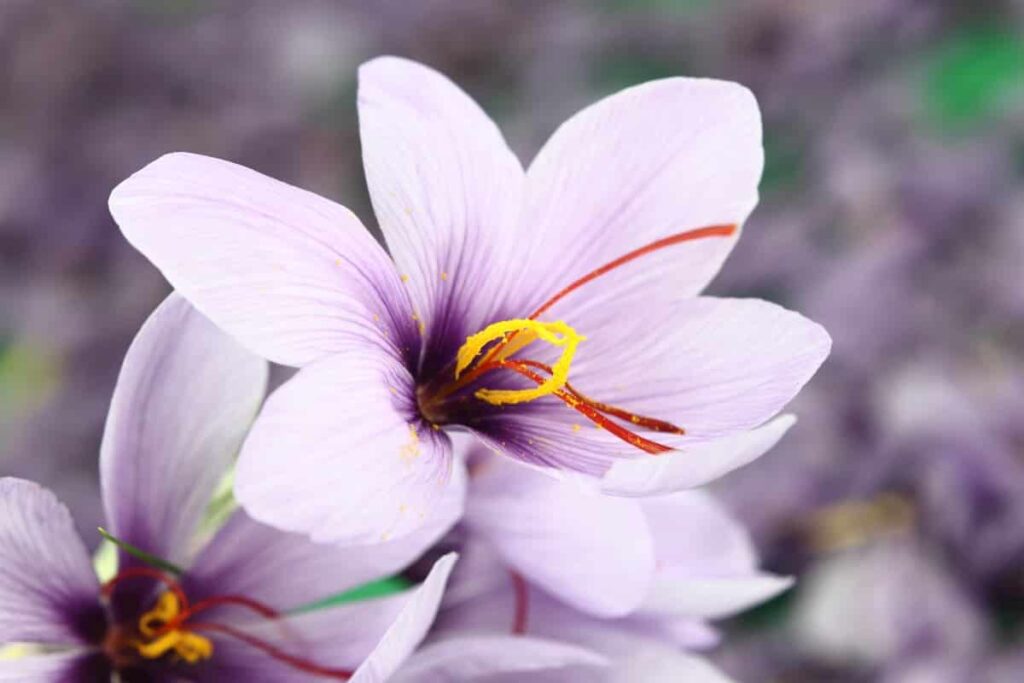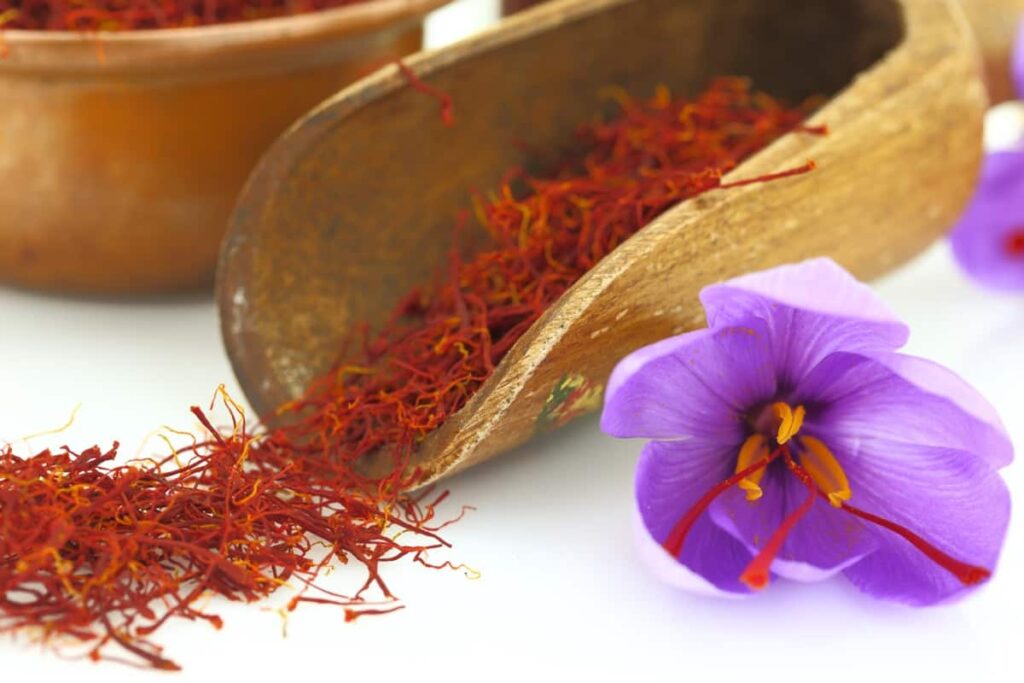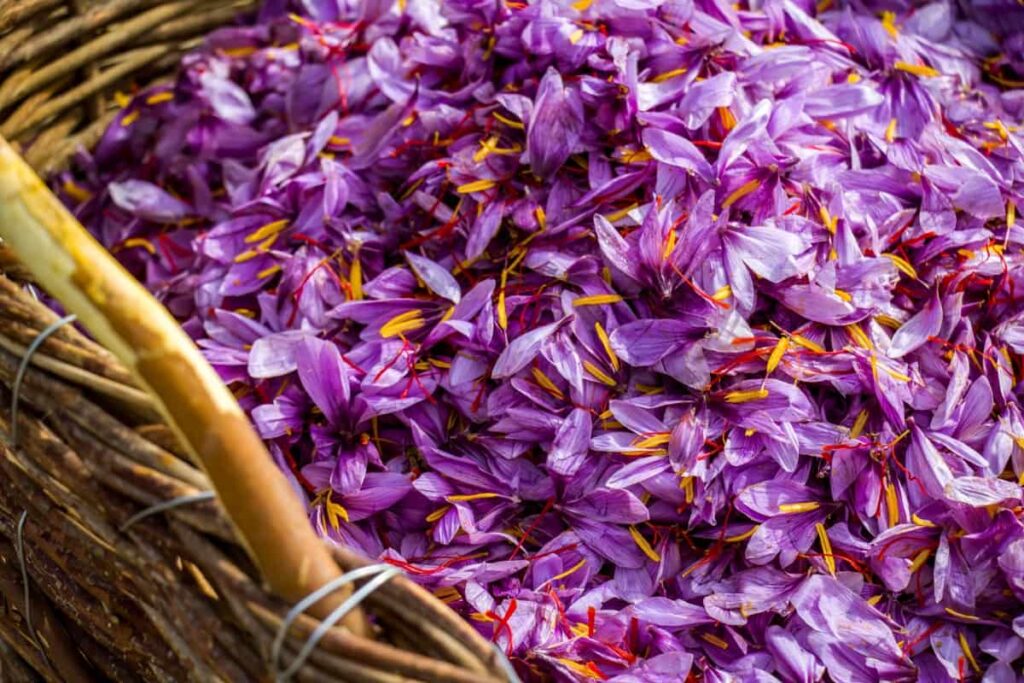Welcome to our blog on hydroponic saffron farming, where we explore the art of cultivating premium saffron using modern techniques. Saffron, renowned for its rich aroma, vibrant color, and unique flavor, has been a highly prized spice for centuries. By harnessing the power of hydroponics, we can revolutionize how saffron is grown, maximizing yield and quality. In this blog, we will delve into the intricacies of hydroponic saffron farming, discussing optimal growing conditions, cost considerations, harvesting methods, and more.

What is Hydroponic Saffron Farming?
Hydroponic saffron farming refers to cultivating saffron (Crocus sativus) using a soilless system where saffron is grown in a nutrient-rich water solution instead of traditional soil-based methods. In this method, the saffron bulbs are planted in an inert growing medium like rockwool or coco coir, and the necessary nutrients are supplied directly to the roots through the water solution.
This approach allows precise control over growing conditions, including temperature, light, and nutrient levels. It maximizes plant growth and yields, improves resource efficiency, and reduces the risk of soil-borne diseases. Hydroponic saffron farming offers a sustainable and innovative way to cultivate this highly valued spice.
Benefits of Hydroponic Saffron Farming
- Increased Yield Potential: Hydroponic systems provide optimal conditions for saffron growth, leading to higher yields than traditional soil-based methods.
- Precise Control over Growing Conditions: Hydroponics allows precise control over temperature, light, humidity, and nutrient levels, creating an ideal environment for saffron plants.
- Resource Efficiency and Water Conservation: Hydroponic systems use water more efficiently than traditional farming, resulting in significant water savings and reduced environmental impact.
- Reduced Risk of Soil-Borne Diseases: By eliminating soil, hydroponic saffron farming minimizes the risk of soil-borne diseases, leading to healthier plants and higher crop quality.
- Year-Round Cultivation Possibilities: Hydroponics enables saffron cultivation regardless of seasonal limitations, allowing for continuous production and the potential for higher profits.
- Space Optimization: Hydroponic systems can be designed vertically, utilizing limited space more efficiently and enabling higher plant densities.
- Enhanced Nutrient Absorption: Saffron plants in hydroponic systems have direct access to a well-balanced nutrient solution, resulting in improved nutrient uptake and plant health.
In case you missed it: A Comprehensive Guide to Saffron Farming Business Plan: Maximizing Your Harvest, Successful Saffron Farming Strategies

Optimal Conditions for Hydroponic Saffron Cultivation
- Temperature and Light Requirements: Saffron plants prefer temperatures between 65°F and 70°F (15°C and 21°C) for proper growth and flowering. Adequate lighting, 12 to 14 hours per day during the flowering stage, is crucial for healthy plant development.
- Humidity and Air Circulation: Maintaining humidity levels around 40% to 60% helps prevent fungal diseases. Proper air circulation is essential to prevent excessive humidity and ensure good ventilation.
- pH and Nutrient Solution Composition: Saffron thrives in a pH range of 6.0 to 7.5. The nutrient solution should provide essential macronutrients (nitrogen, phosphorus, and potassium) and micronutrients (iron, manganese, zinc, etc.) necessary for healthy plant growth.
- Proper Growing Medium Selection: Common hydroponic substrates like rockwool, coco coir, or perlite can be used as growing mediums for saffron, providing support and allowing for effective nutrient absorption.
Growing Saffron in a Hydroponic Garden: Modern Technique
- The planting and harvesting of saffron bulbs typically occur in the fall, when the crocus sativus plant blooms. After harvesting the stigmas, the corms (bulbs) are left to overwinter outdoors and dug up before the next summer.
- In a hydroponic greenhouse setup, saffron corms can be planted in starter plugs and later transplanted into rockwool blocks. Nutrients with varying electrical conductivity (EC) levels are used throughout the growth stages, such as root-building solutions initially and flower-stimulating nutrients when flower buds appear.
- Although rockwool blocks were initially used, it was discovered that saffron corms didn’t root into them extensively. Subsequently, after harvest, the corms were transplanted outdoors into the soil for overwintering.
- Saffron crocus plants exhibit resilience, even in colder climates, and thrive throughout the winter months. Corms are dug up, dried, and stored the following spring for the next cultivation cycle.
- Growing saffron in two-inch mini-blocks proved more efficient in subsequent years than using larger blocks. Nutrient formulas were adjusted to prioritize heavy phosphorous and potassium levels, essential for optimal bulb growth. The aim was to induce higher production of safranal, the organic compound responsible for saffron’s distinctive aroma.
- Maintaining appropriate temperatures is crucial for saffron growth, with a range of 60°F to 70°F being ideal. Greenhouse growers in colder climates may require additional heating methods, such as heat mats and propagation domes, to ensure adequate plant warmth.
- Harvesting saffron involves delicately plucking the stigmas using tweezers. The stigmas are then dried in the microwave or a dehydrator and stored in a cool, dark place with desiccant packets to maintain their dryness.
In case you missed it: Vertical Saffron Farming: The Red Gold Revolution for Excellent Profits

The Growing Conditions of Hydroponic Saffron
Specific growing conditions must be strictly maintained during the three-month cultivation period to maximize yield. Any significant changes to these conditions can significantly impact the saffron crop, potentially resulting in a substantial loss. Constant monitoring is necessary to ensure optimal conditions.
The Best Temperature for Hydroponic Saffron
The ideal temperature range for hydroponic saffron is between 60°F and 70°F. Temperatures below this range can significantly decrease saffron growth rate, while temperatures exceeding 75°F for prolonged periods may lead to flower abortion. Maintaining temperatures around 65°F has been shown to stimulate saffron flowering highly.
The Nutrient Solution for Hydroponic Saffron
Hydroponic saffron requires a nutrient solution with a pH of 5.5 and an electrical conductivity (EC) of 1.4. Separating the nutrient solution of each NFT unit is advisable to minimize the risk of affecting the entire yield. This prevents the spread of diseases or fluctuations in pH and EC values from impacting the entire saffron crop.
Light Requirements of Hydroponic Saffron
Hydroponic saffron requires 14-16 hours of light exposure daily in the pre-flowering period. Once it reaches the flowering stage, light exposure can be reduced to 12-14 hours. Artificial growing lights are typically used as the light source for hydroponic saffron. Relying solely on sunlight would limit yield and hinder the implementation of vertical farming.
Harvesting Hydroponic Saffron
Harvesting saffron bulbs can be a considerable undertaking. Hiring labor experienced in vertical hydroponic farming can simplify the process. The stigma threads in the center of each saffron flower are the most important part, requiring careful handling during harvesting.
Drying and Storing Hydroponic Saffron
After collecting the stigma threads, proper drying and storage are crucial. Dehydration under controlled temperatures involves heating the saffron threads in a sieve over a gas stove at 122-176°F for 30-60 minutes. The saffron must reach a maximum moisture content of 5-15% before being stored in airtight plastic bags. Moisture levels above 15% can lead to spoilage due to fungi.
In case you missed it: Hydroponic Farming in Kenya: Project Report, Cost and Profit Analysis

Indoor Hydroponic Saffron Cultivation
- During the beginning of autumn, it is crucial to gradually decrease the temperature by one °C per day until reaching the optimal temperature of 20°C. Additionally, gradually introduce sunlight to reach a lux level 800 during the day. Increase the CO2 levels gradually, reaching 2000 ppm over the first week. The humidity should be increased to 70% during this adjustment period.
- Maintain these parameters for the next three weeks: 20°C during at day and 17°C at night, CO2 levels at 2000 ppm throughout the day and night, and relative humidity at 70%.
- Within these critical three weeks, the bulbs will sprout, and the flower stalks will emerge from the bulbs utilizing the accumulated nutrients. After three weeks, the stalks should reach an average height of approximately 3-4 cm.
- In the upcoming week, adjust all levels to subject the bulbs to a cold shock, which improves flowering. It is important to note that “shock” refers to a gradual adjustment, not a sudden temperature change. Mimic is a natural process by gradually adjusting all temperatures and values.
- Lower the temperatures from 20°C to 12°C during the day and from 17°C to 10°C during the night. Reduce the CO2 levels from 2000 to 700 ppm, and increase the relative humidity to 85%.
- Maintain these levels for one week. Then, slightly increase the temperatures to 17°C (day) and 14°C (night). Maintain CO2 levels at 700 ppm and provide 1000 lux of light. The flowers should mature within the next two weeks, signaling they are ready for harvesting.
- To harvest, snap the flower stalks and collect them in an open basket lined with cloth. Follow the instructions for processing the flowers. The bulbs are ready to be vegetated in open soil at this stage.
- Ensure sufficient nutrients (such as mature cow dung, humic acid, and Acadian) are provided to promote bulb propagation and growth for the next crop cycle.
- Use a light and exhaust system measuring 100 x 200 cm. For the CO2 enricher and humidifier conditioner, specific specifications are needed.
In case you missed it: A Comprehensive Guide to Understanding the Working Model of Hydroponic Farming

Profitability of Hydroponic Saffron Farming
Hydroponic enthusiasts want to earn a significant income from their crops, particularly saffron, due to its high price. To achieve this, saffron must be grown indoors, with better control over growing conditions, and four times a year. To yield 10 pounds of dried saffron per season, 675,000 Crocus Sativus bulbs must be grown.
The nutrient film technique (NFT) hydroponic system is preferred due to its small size, with each NFT unit having 72 spots. To grow 675,000 saffron bulbs, approximately 4,687 NFT units are required. Vertical farming with three levels saves space, as saffron plants have a short height of 8 to 12 inches. The total growing area needed to accommodate 675,000 saffron bulbs using a three-level vertical farming hydroponic system is approximately 6,250 square feet.
How Much You Can Expect to Earn from Growing Hydroponic Saffron
Growing hydroponic saffron requires harvesting flowers, resulting in a realistic goal of bulbs. A three-level vertical hydroponic system can yield 10 pounds of dried saffron threads per growing period, generating a total sales per quarter of $25,000. With a three-month growing period, saffron can be grown four times yearly, resulting in a total income of $100,000.
Costs of Growing Hydroponic Saffron
Growing saffron flowers requires significant effort, including labor costs for harvesting and care. Monthly expenses like electricity, electricity costs due to artificial growing lights, air pumps, water pumps, and climate control systems, and labor costs for hiring workers to harvest bulbs every three months can be financially burdensome. For example, 150,000 saffron flowers typically require 40 hours of labor, resulting in approximately 180 continuous labor hours during the harvest stage, excluding care during the three-month growing period.
Hydroponic Saffron Price
Saffron, one of the most expensive spices, has maintained its high price since the 7th century. Wholesale prices for saffron can range from $500 to $5000 per pound, with the cost primarily dependent on the quality of the dried saffron produced. The highest-quality saffron can fetch prices of $5000 or even $6000 per pound.
While the profitability of growing saffron through hydroponics is enticing, it’s important to consider certain aspects. The mentioned prices are for a pound of dried saffron spice. Around 200,000 stigmas must be collected from approximately 70,000 saffron flowers to obtain one pound of fresh saffron.
Processing and Drying of Hydroponic Grown Saffron
Commercial saffron is derived from the dried stigma of the saffron plant. The distinct taste of saffron, both bitter and special, is attributed to picrocrocin. Safranal, another component of saffron, contributes to its fragrance. The color of saffron comes from the water-soluble carotenoid dye called crocin. To ensure long-term storage of saffron, the fresh saffron stigmas must be dried.
The drying method employed significantly affects the quality of saffron. In Iran, four traditional methods of drying saffron stigmas were examined: using electric ovens at four different temperatures, infrared MJ at six different temperatures, and dried microwaves at three different power settings. Spectrophotometry was employed to quantitatively measure the amount of crocin, picrocrocin, and safranal compounds in the dried samples.
In case you missed it: How to Grow Bok Choy Hydroponically: A Step-by-Step Guide for Planting to Harvesting

The results indicated that higher temperatures led to higher levels of safranal in the dried samples. Furthermore, samples dried at 90-80°C exhibited the highest amounts of crocin. Temperatures above 90°C resulted in heat degradation, while lower temperatures caused enzymatic degradation of pigments, leading to lower crocin levels.
Challenges of Hydroponic Saffron Farming
Hydroponic saffron farming faces challenges, including initial infrastructure, equipment, and systems investment. Bulb selection and sourcing are essential for successful cultivation, with bulbs with a minimum diameter of 1 inch from reputable sources. Effective pest and disease management is crucial, with regular monitoring, preventive practices, and organic treatments.
Maintaining optimal nutrient balance is crucial, with macronutrients like nitrogen, phosphorus, and potassium and micronutrients like iron, manganese, zinc, copper, and boron supplied in appropriate concentrations. Regular monitoring and adjusting the solution ensures optimal nutrient balance for healthy saffron plants.
Conclusion
Hydroponic saffron farming offers numerous benefits, including increased yields, precise control over growing conditions, resource efficiency, and reduced disease risk. By harnessing modern techniques, saffron cultivation can be optimized, producing premium-quality saffron.
- How to Raise Pigs in Your Own Backyard: A Comprehensive Guide
- Budget Friendly Sheep Shed Ideas: Cheap and Low-Cost Tips
- How Much Do Cattle Farmers Make: Revenue Streams in Cattle Farming
- Management Pests and Diseases in Your Cotton Field
- Sheep Farming Business Plan for Beginners
- Aquaponic Farming at Home: A Step-By-Step Guide
- Profitable Village Farming Business Ideas in 2024
- High-Yield Aquaculture: Fast-Growing Fish for Farming
- Effective Fish Pond Construction Techniques for Beginners
- Irrigation and Water Management in Pineapple Farming
- Blossom to Harvest: Mastering Flowering and Pollination in Papaya Farming
- Pig Fattening Essentials: From Selection to Sale for Beginners
- Raising Wagyu Cattle: A Complete Guide for Premium Beef Production
- Soil Types and Their Water Holding Capacity
- Optimizing Irrigation Schedules for Coconut Groves for Enhanced Yield
- Espresso Your Garden: Coffee Grounds for Healthier Acid-Loving Plants
- The Best Soil Mix for Snake Plants: How to Mix Your Own Snake Plant Soil
- Green Thumb Success: Expert Tips for Cultivating Greenhouse Beans All Year Round
- Bloom All Year Round: The Ultimate Guide to Indoor Hyacinth Care
- Eco-Friendly Gardening: How to Make Liquid Fertilizer from Kitchen Waste
- Ultimate Guide to Grow Anise in Pots: Explore Seed Propagation to Harvesting
- Guide to Raising Chester White Pigs: Discover Breed Facts to Growth Management
- Mastering the Elegance: The Ultimate Guide to Weeping Cherry Tree Care, Planting, and Maintenance
- Ultimate Guide to Planting Garlic in Grow Bags: Growing Strategies for Beginners
- How to Fix Spider Plant Leaf-Related Problems: Natural and Organic Remedies
- 10 Reasons Why Your Tulsi Plant is Shedding Leaves: Home Remedies and Solutions
- Optimizing Growth and Yield: The Advantages of Palm Bunch Ash Fertilizer
- Utilizing Neem Oil Extract as a Natural Pesticide for Hydrangea
- From Soil to Harvest: Various Ways in Which Farmers Can Use AI Tools
- Steps to Encourage and Induce Citrus Flowers: A Comprehensive Guide
- How to Fix Snake Plant Leaf-Related Issues: Natural and Organic Remedies
- Transform Your Garden into a Fragrant Oasis with Raat Ki Rani (Night Blooming Jasmine)
- Discover the Ideal Chicken Breeds for Philippine Farms
- How to Create a Poultry Egg Farm Business Plan for Profits
- Grow Lemon Cucumbers Like a Pro: Insider Techniques for Bountiful Yields
- Ultimate Guide to Caring for Your Pink Princess Philodendron: Tips for Thriving Variegation
